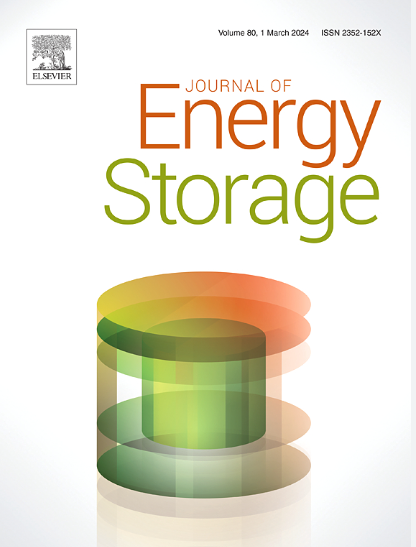Recovery of lithium from spent LFP and NCA batteries by electro-oxidation process and synthesis of cathode material from recycled precursors
IF 8.9
2区 工程技术
Q1 ENERGY & FUELS
引用次数: 0
Abstract
The rising demand for lithium across various applications underscores the urgent need for sustainable recycling practices. This study highlights the critical importance of recycling lithium-ion batteries, given the finite nature of lithium resources and the environmental impact of improper disposal. The research presents an efficient method for lithium recovery from spent batteries, including LiFePO4 (LFP) and LiNixCoyAlzO2 (NCA) types. This approach utilizes selective lithium recovery via electro-oxidation, applying varying potentials to enhance lithium extraction from spent Li-ion batteries. This technique overcomes the limitations of traditional methods, achieving higher yields and minimizing losses.
Lithium recovery efficiency is assessed through inductively coupled plasma (ICP) analysis of the resulting solution. The recycled lithium precursors are then employed to synthesize new LiCoO2 (LCO) cathodes. Electrochemical evaluations show that the newly synthesized LCO exhibits a capacity of 136 mAh/g at a charge rate of 0.1C and a Coulombic efficiency of 99 %. These results confirm the effectiveness of the electro-oxidation process in recovering lithium as Li2CO3, facilitating the successful development of high-performance LCO cathode materials.
This study emphasizes the significance of sustainable battery recycling, offering a viable solution to the challenges of mineral scarcity, particularly lithium. It demonstrates a method that provides selectivity for different battery chemistries and compositions, advancing the field of recycling technologies.

通过电氧化工艺从废 LFP 和 NCA 电池中回收锂,并利用回收的前体合成正极材料
各种应用领域对锂的需求不断增加,这凸显了对可持续回收实践的迫切需求。鉴于锂资源的有限性和不当处置对环境的影响,本研究强调了回收锂离子电池的极端重要性。研究提出了一种从废旧电池(包括 LiFePO4 (LFP) 和 LiNixCoyAlzO2 (NCA))中回收锂的高效方法。这种方法通过电氧化进行选择性锂回收,利用不同的电位提高废旧锂离子电池的锂提取率。通过对所得溶液进行电感耦合等离子体 (ICP) 分析来评估锂回收效率。然后利用回收的锂前驱体合成新的钴酸锂(LCO)阴极。电化学评估显示,新合成的 LCO 在充电速率为 0.1C 时的容量为 136 mAh/g,库仑效率为 99%。这些结果证实了电氧化工艺在以 Li2CO3 形式回收锂方面的有效性,从而促进了高性能 LCO 正极材料的成功开发。这项研究强调了可持续电池回收的重要性,为解决矿物质稀缺(尤其是锂)的挑战提供了可行的解决方案。它展示了一种可为不同电池化学成分和组成提供选择性的方法,推动了回收技术领域的发展。
本文章由计算机程序翻译,如有差异,请以英文原文为准。
求助全文
约1分钟内获得全文
求助全文
来源期刊

Journal of energy storage
Energy-Renewable Energy, Sustainability and the Environment
CiteScore
11.80
自引率
24.50%
发文量
2262
审稿时长
69 days
期刊介绍:
Journal of energy storage focusses on all aspects of energy storage, in particular systems integration, electric grid integration, modelling and analysis, novel energy storage technologies, sizing and management strategies, business models for operation of storage systems and energy storage developments worldwide.
 求助内容:
求助内容: 应助结果提醒方式:
应助结果提醒方式:


